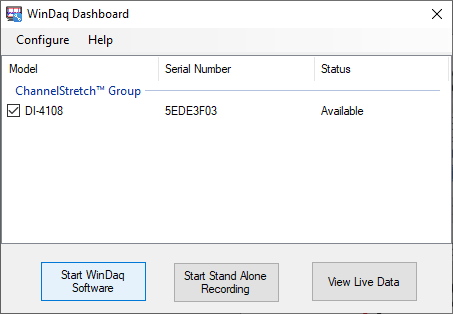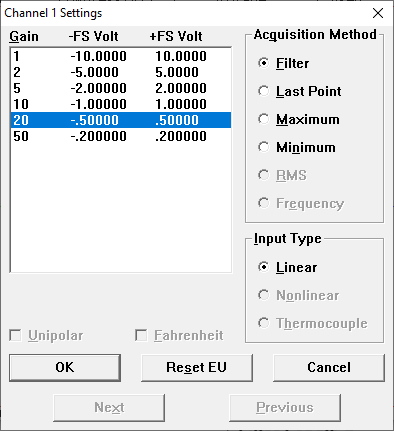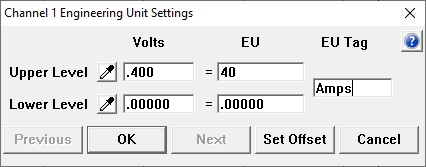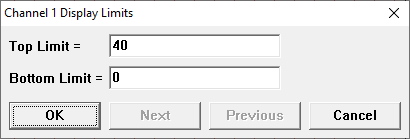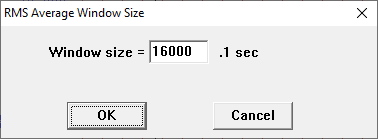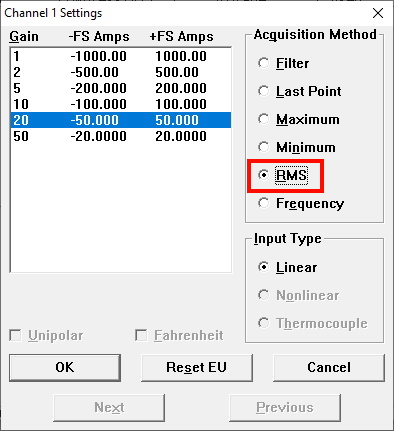In this article, I will show you how to display and record current (Amps) using a DATAQ Instruments model DI-4108-U, WinDaq data acquisition software and a 400 Amp AC/DC current probe (Electronic Specialties Model 697). I’ll use the current information to determine how much energy is used in a typical household appliance.
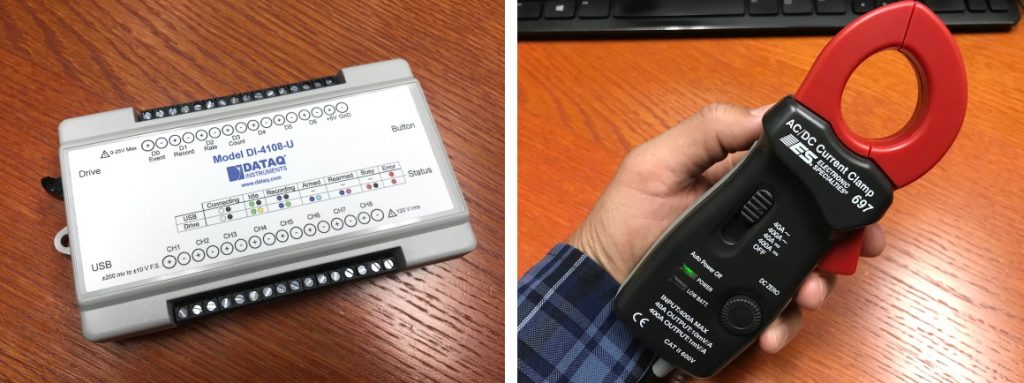
I chose the DI-4108-U because it is a general-purpose, readily available data logger, featuring programmable measurement ranges from ±200 mV to ±10V full scale. Depending on whether or not you will be taking other measurements or where the device will be deployed, you may want to choose a different device (see the list of compatible devices below).
In the United States, AC current flows into a household electrical device through insulated cables that typically have three wires running through them; a hot wire, ground and a neutral.
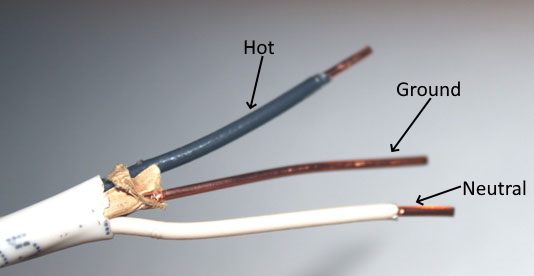
In this example, I will monitor the current draw of a toaster oven as it goes through a simulated cook cycle. Because current flows through the ground wire and the hot wire in opposite directions, if we were to clamp around both wires, we would get a net current reading of 0 (zero) Amps. In order to clamp around just the hot wire, we’ve opened up the power cable to gain access to the wires inside (we DO NOT recommend doing this at home).
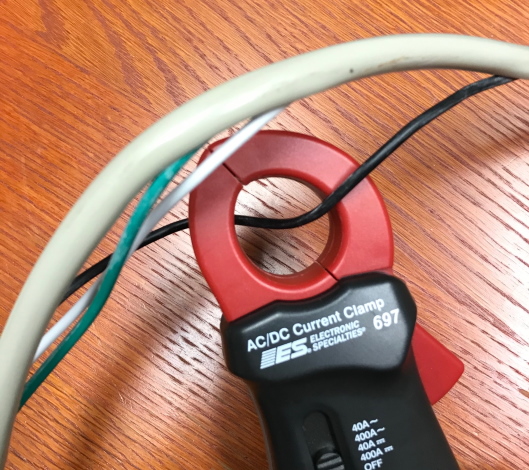
Connection
I am using an Electronic Specialties Model 697 AC/DC current clamp. On the 40A AC setting, the output is 10mV/A (there’s also a 400A range). The current clamp has two output wires (red and black) that I’ll connect to analog channel 1 on the DI-4108-U (as shown below).
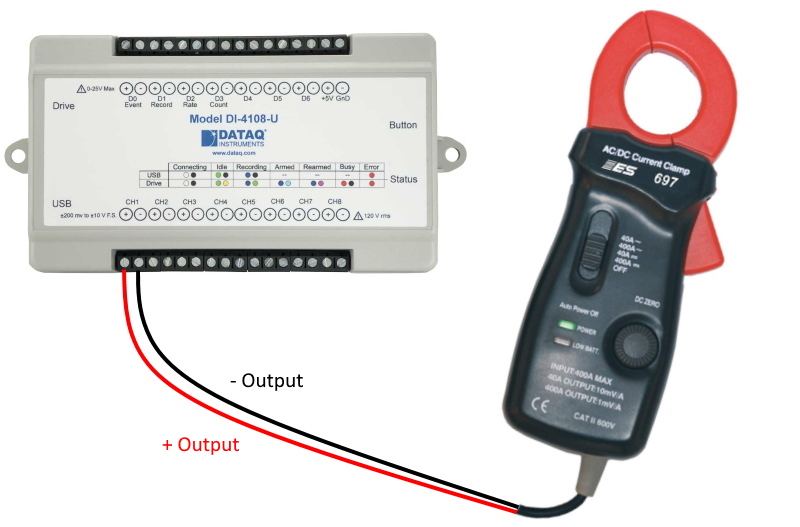
Setup and Scaling
Once connected, configure WinDaq to display current on channel one.
Connect the DI-4108-U to an available USB port on your PC and run the WinDaq Dashboard. Select the DI-4108-U and start WinDaq data acquisition software.
Select ‘Channel Setting’ from the ‘Edit’ pull-down menu. Since we know that the current clamp has a maximum output of 0.400V (10mV/Amp on the 40A range), we’ll choose a gain of 20 (±0.500V). This gives us the best possible resolution over the full scale output of the current clamp.
Next, scale WinDaq to display current (Amps) instead of volts:
- Select ‘Engineering Unit Settings’ from the ‘Edit’ pull-down menu.
- Since the output of the current clamp is 0.400V at 40 Amps, enter 0.400 for Upper Level Volts and 40 for Upper Level EU.
- For both Lower Levels (Volts and EU) enter 0.
- In this example, we’ll make the EU Tag Amps.
Optimize the waveform display to match the full scale measurement range of the current clamp (40 Amps). Select ‘Limits’ from the ‘Scaling’ pull-down menu and enter ’40’ for the Top Limit, and ‘0’ as the Bottom Limit.
Because I am using the 40A AC setting to acquire AC current; rather than displaying instantaneous values, we’ll use the RMS acquisition method* to display the average AC current.
Choose ‘Preferences’ from the ‘Edit’ pull-down menu, select ‘Maximum Sample Rate’ and UNCHECK the Auto option.
Next I will select an RMS window size by selecting ‘Preferences’ from the ‘Edit’ pull-down menu and choosing ‘RMS Window Size’. The window size is the size of the sample being used by WinDaq to calculate RMS. I want the window size to encompass several complete cycles of the waveform. Since I am looking at a 60 Hz signal, the period (time taken to complete one cycle) is 16.67 ms. I will choose a window size of 0.1 seconds (100 ms), encompassing almost six complete cycles.
With the Auto option unchecked and a RMS window size chosen, select the RMS acquisition method from the Channel Settings window (Edit>>Channel Settings).
WinDaq is now configured to display RMS current.
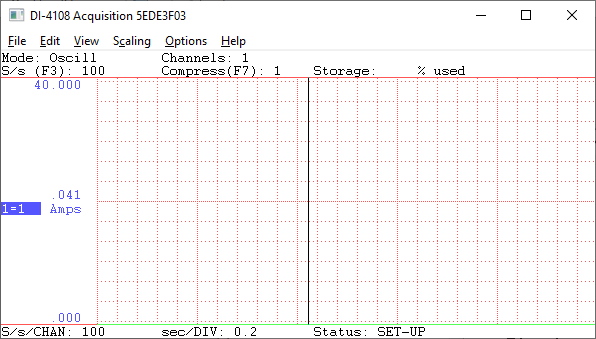
Making the Current Measurement
Now I will insert a bagel, choose a cook setting and power up the toaster oven.

As you can see below, once powered, RMS current jumps from 0 to roughly 12 amps RMS in about 110 ms.
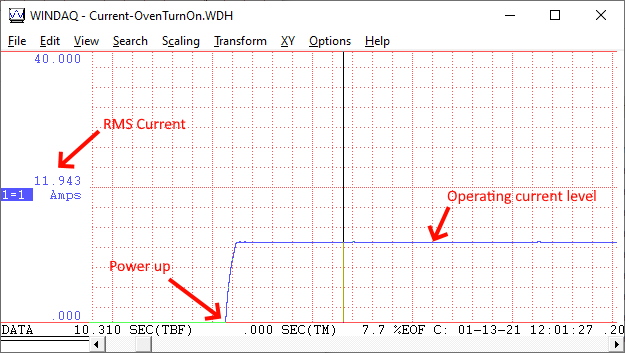
Plugged into a 120 VAC outlet and drawing approximately 12 Amps, we find that the toaster oven consumes 1,440 Watts (Watts = Volts x Amps).
Calculate watt-hours (Wh) by multiplying the power (in Watts) by the number of hours the toaster oven is in use.
So if we use our toaster oven two hours a day, we’re consuming 2,880 Wh.
Conclusion
Using a simple, inexpensive current clamp with an off-the-shelf DATAQ Instruments data logger and WinDaq data acquisition software, you can easily monitor and record current data. The acquired current data can then be used to derive other important information, such as power consumption.
Other compatible devices include:
*Learn more about the RMS acquisition method at https://www.dataq.com/data-acquisition/general-education-tutorials/frequency-true-rms-daq.html


 View Cart
View Cart sales@dataq.com
sales@dataq.com 330-668-1444
330-668-1444